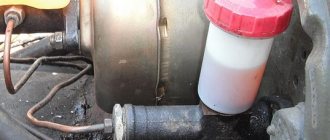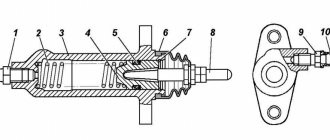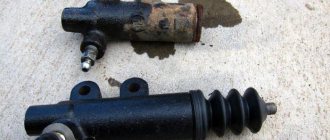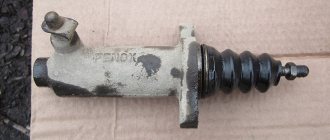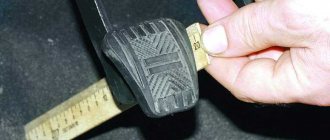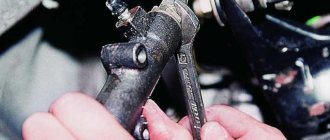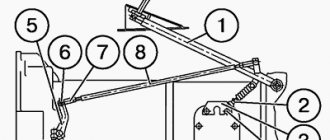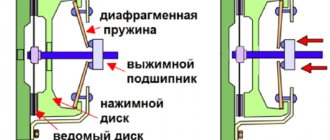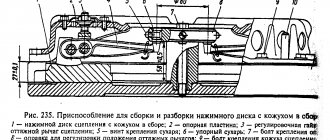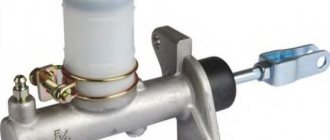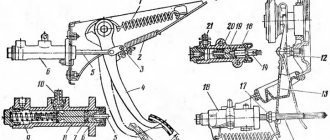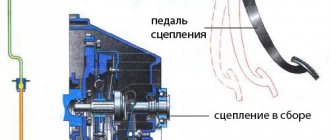Article navigation
By pressing the pedal, the driver acts on the fluid in the line. The fluid transfers pressure from the master cylinder piston to the slave cylinder piston. The master cylinder moves the fork piston.
The release fork presses against the release bearing, which transmits force to the clutch mechanism, which disengages the transmission from the transmission.
By releasing the pedal, the driver returns the entire mechanism to its original state. Under the action of the return spring, all elements involved in the process of disengaging the clutch assume their normal positions, this is how the UAZ loaf clutch works
Operation of the GVC
Below is a brief description of how the clutch works:
- When you press the clutch pedal, the pusher moves the piston and the compensation hole closes.
- It pushes fluid in front of it into the system, creating pressure.
- This pressure acts on the piston of the working cylinder, which pushes the rocker arm through the rod.
- The fork, moving the release bearing, acts on the crankcase petals, releasing the pressure plate from the clutch disc.
The valve and disc play an important role in the pumping process. Even if the system is not primed, it will still fill up. Simply unscrew the master cylinder valve and allow the fluid to flow through it. It fills the system by gravity, the same applies to the brakes.
The liquid enters through the expansion port into the cavity in front of the piston through the valve into the line. When filling is complete, the liquid flows out through the valve. The most important thing is that the piston rod should not be extended, and the expansion hole should not be blocked by the handle.
When pumping, everything happens a little differently.
- When the piston moves forward, valve 19 is open.
- When moving backwards, the valve is closed and the front valve creates a vacuum.
- There are holes in the piston that are closed by plate 3. It retracts and opens the holes. Liquid flows from the space above the piston and reservoir through the bypass hole into the space in front of the piston, which is under pressure. The collar (cork) allows it to overflow.
- When the lock ring is reached, the piston stops and the spring compresses the plunger and plate. It's ready for a new cycle.
Clutch design of the most common UAZ models
The entire clutch system UAZ loaf
First, let's define the term "clutch". It is necessary for smooth connection and disconnection of the crankshaft with the vehicle transmission. This is necessary when changing the driving mode (changing gears in the transmission) or stopping the car. The UAZ 469 military jeep was equipped with a dry single-plate clutch, a very popular system in the automotive world at that time. This coupling consisted of the following components:
- pressure disk in the housing;
- special pressure springs and clutch release levers;
- friction disc equipped with friction linings.
The general design looks like this. The so-called casing (clutch housing with all mechanisms) is bolted to the crankshaft. Alignment is established according to the factory marks on the housings. It is important to understand that when the driven and driven plates touch, a tremendous amount of friction is created to transfer torque from the crankshaft to the vehicle's transmission, which transfers it to the wheels.
The pressure plate is installed together with springs, protected from overheating by special insulating washers on the side of the pressure plate. For this reason, the basket is made of alloy and leaves ventilation holes, and the pressure plate is installed together with springs, which are protected from overheating by special heat-insulating gaskets on the side of the pressure plate.
Let's look at the clutch control mechanism itself. It consists of:
- unlocking levers that are installed on the pressure plate;
- release clutch with thrust roller bearing;
- Clutch selector fork mounted on the crankcase.
UAZ owners know that it is difficult to get to the clutch without removing the engine; you need an overpass or an inspection channel.
It is clear that in order to begin repairing a particular unit, you need to understand where the fault is, and only diagnostics can provide such understanding.
Return to contents
Design
Unlike front-wheel drive foreign cars, on all-wheel drive UAZ Patriot vehicles the clutch slave cylinder (its adjustment is at the end of the article) is hydraulic and is controlled using fluid pressure, and not a cable. The design of this element includes several components. This:
- Frame. It is made of plastic or metal.
- Piston (working rod).
- A valve that releases air when the clutch system is bleeding (adjusting).
- Retaining ring.
- O-rings. Made from durable rubber.
- Return spring.
- Pusher. It affects the previous element.
Clutch master cylinder repair kit
The quality of UAZ clutch cylinders leaves much to be desired. Some car enthusiasts converted them to VAZ cars, which are more reliable. I also refused to use repair kits, since there are no fewer problems with them. Given the low cost of repairs, the service life of the repaired GVC was from a month to six months.
- unscrew the main fitting;
- remove the retaining ring;
- push the cuff with the piston towards the stopper;
- wipe all parts and the inside of the cylinder with a clean cloth;
- make sure his mirror is not scratched;
GCS assembly
- replace the ring cuff;
- on the stopper side, put the piston in place and install the stopper;
- on the side of the fitting, place a plate and 2 cuffs;
- insert the spring and tighten the fitting by squeezing.
Signs of trouble
How do you know if your car needs to replace the clutch slave cylinder? UAZ is a very reliable car, but this part can also fail. A breakdown can be determined by several signs. Firstly, this is a sharp decrease in the liquid level in the tank. If there is a leak, the cylinder boot may have broken through. Damage may also affect rubber or aluminum tubes. Check their integrity. Secondly, the pedal stroke becomes softer. “Clutch failures” are observed. This indicates the presence of air in the system.
Frequent malfunctions and their causes
The clutch system of a UAZ vehicle is characterized by various malfunctions: the clutch is strengthened, the mechanism does not disengage, slips or does not pump. Timely maintenance, replacement of worn parts, lubrication and monitoring of the liquid level in the tank, diagnostics of all systems and components of the mechanism help to avoid such problems.
The operating instructions provide basic information about the operation of transport units, their preparation for operation, the rules and frequency of monitoring the functionality of the units, the main malfunctions and the decoding of error codes. Following the manufacturer's recommendations will extend the life of the equipment. Simple breakdowns can be fixed yourself.
For more complex system malfunctions, it is recommended to contact a service center.
The first category of reasons relates to the problem when the system cannot start completely when the pedal is lowered. The algorithm of actions is as follows:
- Lack of free play on the pedal. Repair measures consist of adjusting the shutdown drive.
- A malfunction in the pressure plate movement design requires replacement of the part or removal of the cause of the jam.
- Defective pressure springs, reduced force. Purchasing new spare parts will help correct the situation.
- Oil getting on the friction surface of the discs. It is necessary to rinse and wipe the elements dry with gasoline.
- Prolonged slippage causes overheating. The mechanism will cool down on its own after some time.
If the system starts up jerkily or with vibration, the reasons may be as follows:
- Oil getting on the friction surface of the discs. It is necessary to install a new part or wipe the old one with gasoline, remove protruding irregularities on the surface of the pressure plate and flywheel.
- Friction linings worn down to the rivets indicate the need for immediate replacement of the component.
- Incorrect placement of the pull levers. It will be necessary to dismantle the clutch and adjust the components.
If an extraneous noise occurs when you press the pedal, this may indicate that the bearing has become unusable or lacks lubrication. If using oil does not help, you will need to purchase a new element. A break in the release spring makes it impossible to lock the pedal in the upper position. The spring needs to be replaced.
Clutch disappears
Often the mechanism does not start or disappears after the vehicle has been idle for a long time. The probable cause is “sticking” of the driven disk to other structural elements. If several attempts to start the car do not lead to success, it is better to contact a service center. In this case, you will not be able to correct the situation on your own.
Drives the clutch
A common group of malfunctions is associated with a situation where the clutch is driven and there is no way to completely disengage the mechanism. There could be several reasons:
- Free play is greater than the permissible limit. An adjustment needs to be made.
- Damage to the driven disk. It is necessary to change or, if possible, correct the deformation.
- Destruction of driven disk elements. There is only one way out - to purchase a new part.
- Air entering the hydraulic piping system. Pumping the mechanism will help correct the situation.
- Hub jamming. Remove nicks, foreign elements, burrs and other causes of structural malfunction.
- Incorrect placement of the pull levers. It will be necessary to dismantle the clutch and adjust the components.
Increased clearances in the drive also indicate the need to replace worn components.
DIY replacement
First you need to drain the remaining liquid in the system. This can be done using a syringe. This operation is necessary to flush out dirt from the hydraulic drive system. On some models, access may be blocked by the cooling system expansion tank. For convenience, remove the container’s fastening nuts and remove the hose. It should be unscrewed with a 10mm wrench. Next, we dismantle the metal tube that comes from the clutch master cylinder. It can be copper or aluminum. After this, we remove the main cylinder, having previously unscrewed the two fastening nuts with a 13mm wrench. Using a 17 socket, you need to remove the hose that comes from the working cylinder. Next we will need the key for 13 again.
Checking the correctness of the changes made
To confirm the correctness of the results of the adjustments made, it is necessary to check the operation of the clutch assembly with the car engine running.
To do this you need:
- Start the engine and put the car on the handbrake.
- Depress the clutch and engage gear. The lever should move easily to any position, and the speed should not increase.
- Smoothly release the pedal until the crankshaft speed begins to decrease. In this case, the drive must be at a distance from the floor of at least 1/3 of the free play.
- Disengage the clutch and turn off the engine.
After this, the correct adjustment of the sensor is checked while driving. If the speed does not increase when the clutch is turned off, and the machine does not jerk when turned on, then the adjustment has been carried out correctly. Otherwise, you will have to perform all the procedures again.
DIY repair
So, the part has been removed and is ready for disassembly. First, unscrew the air bleed valve and remove the retaining ring. After disassembling the part, we inspect the condition of all elements - spring, piston, pusher and sealing rubber bands. They must not show any signs of mechanical damage. Next, we wash the insides of the element. There is no need to do this with aggressive liquids like gasoline and diesel fuel. Fill a medical syringe with hydraulic fluid and use pressure to clean out the dirt inside it.
When should you not restore?
In some cases, repairs will not work. The working cylinder is replaced if the housing is damaged (cracks) or there is a large hole inside it. The latter may occur due to a faulty or defective rod. In case of any of these malfunctions, the UAZ clutch slave cylinder is replaced entirely with a new one. The cost of the element is about five hundred to six hundred rubles. The clutch master cylinder costs a little more - 750 rubles. The repair kit can be purchased at a price of 150 to 200 rubles. The amount is not impressive, so if you have limited time, it is better to immediately replace the element with a new assembly. After the clutch slave cylinder is installed, the UAZ needs to be “pumped”. This way we will eliminate all existing air pockets in the lines and adjust the normal pedal travel.
Site about SUVs UAZ, GAZ, SUV, CUV, crossovers, all-terrain vehicles
During operation of the UAZ, as its clutch wears out, adjustment of the pedal position may be necessary in the event of unpleasant situations when engaging one of the gears becomes difficult and it engages normally only after several successive presses of the clutch pedal.
In some cases, the situation can be corrected by changing the position of the clutch pedal, raising or lowering it slightly. For this purpose, as well as to adjust the full travel of the clutch pedal, an adjustment unit is provided at the master cylinder.
Adjusting the full travel of the UAZ clutch pedal.
The position of the clutch release pedal and its full travel is regulated by changing the length of the pusher of the clutch master cylinder. To do this, loosen the nut of the pusher adjustment unit, disconnect the pusher fork from the pedal and turn it in the desired direction to achieve the required result.
Leveling up
After successful installation and assembly of the element, it is necessary to fill in new hydraulic fluid. The same one is used as for the brake system. After this, unscrew the air valve of the working cylinder several turns and press the clutch pedal 5-7 times. To avoid running to the salon several times, call an assistant who will bleed the system. Be careful - when you press the pedal, hydraulic fluid will flow out of the valve. Therefore, prepare the container first. This could be an ordinary mineral water bottle.
Removing air from the drive hydraulic system
Quite rarely, but it happens that the clutch needs bleeding. This can be understood from the fact that it does not turn off completely and the pedal is not pressed so softly. Bleeding is the removal of air from the hydraulic system. This process is carried out when the liquid in the tank is at a normal level.
During work, it is necessary to remove the rubber cap located on the bypass valve and install a hose in this place. Then the other end of the hose is lowered into a 0.5 liter container containing brake fluid in a ratio of 1:3.
Afterwards, the bypass valve must be turned one turn while another person presses the pedal all the way. You need to press the pedal until the air bubbles stop being released. The bypass valve must then be tightly closed.
Some UAZ owners may recommend tightening the bypass valve after each pedal press. This will help to significantly increase the pumping speed and achieve complete neutralization of air. Usually the air disappears from the system after the third or fourth repetition of the operation.
UAZ cars are very reliable. It doesn't take much effort to fix clutch related problems. You can carry out all the work yourself or contact a technical service. Clutch repair or adjustment is not an expensive service. As the owner of one of the UAZ series of cars, you need to carry out timely and constant care of the car, since an unscrupulous attitude can lead to severe pollution and lead to a number of difficult-to-solve problems.
The principle of operation of the clutch on the UAZ loaf
By pressing the pedal, the driver acts on the fluid in the line. The fluid transfers pressure from the master cylinder piston to the slave cylinder piston. The master cylinder moves the fork piston.
The release fork presses against the release bearing, which transmits force to the clutch mechanism, which disengages the transmission from the transmission.
By releasing the pedal, the driver returns the entire mechanism to its original state. Under the action of the return spring, all elements involved in the process of disengaging the clutch assume their normal positions, this is how the UAZ loaf clutch works
Operation of the GVC
Below is a brief description of how the clutch works:
- When you press the clutch pedal, the pusher moves the piston and the compensation hole closes.
- It pushes fluid in front of it into the system, creating pressure.
- This pressure acts on the piston of the working cylinder, which pushes the rocker arm through the rod.
- The fork, moving the release bearing, acts on the crankcase petals, releasing the pressure plate from the clutch disc.
The valve and disc play an important role in the pumping process. Even if the system is not primed, it will still fill up. Simply unscrew the master cylinder valve and allow the fluid to flow through it. It fills the system by gravity, the same applies to the brakes.
The liquid enters through the expansion port into the cavity in front of the piston through the valve into the line. When filling is complete, the liquid flows out through the valve. The most important thing is that the piston rod should not be extended, and the expansion hole should not be blocked by the handle.
When pumping, everything happens a little differently.
- When the piston moves forward, valve 19 is open.
- When moving backwards, the valve is closed and the front valve creates a vacuum.
- There are holes in the piston that are closed by plate 3. It retracts and opens the holes. Liquid flows from the space above the piston and reservoir through the bypass hole into the space in front of the piston, which is under pressure. The collar (cork) allows it to overflow.
- When the lock ring is reached, the piston stops and the spring compresses the plunger and plate. It's ready for a new cycle.
Clutch design of the most common UAZ models
The entire clutch system UAZ loaf
First, let's define the term "clutch". It is necessary for smooth connection and disconnection of the crankshaft with the vehicle transmission. This is necessary when changing the driving mode (changing gears in the transmission) or stopping the car. The UAZ 469 military jeep was equipped with a dry single-plate clutch, a very popular system in the automotive world at that time. This coupling consisted of the following components:
- pressure disk in the housing;
- special pressure springs and clutch release levers;
- friction disc equipped with friction linings.
The general design looks like this. The so-called casing (clutch housing with all mechanisms) is bolted to the crankshaft. Alignment is established according to the factory marks on the housings. It is important to understand that when the driven and driven plates touch, a tremendous amount of friction is created to transfer torque from the crankshaft to the vehicle's transmission, which transfers it to the wheels.
Principle of operation
UAZ Patriot cars have the following type of clutch: single-disk with a centrally located diaphragm spring. By the type of friction it is dry, by the mode of activation it is constantly closed. Diaphragm clutch is also called petal clutch. This type is also used in other UAZ models: 3741 “loaf”, SUVs 469, 3151. Petal is also used for cars of other brands.
It consists of the following parts:
- pressure disk (basket),
- clutch disc (driven),
- release bearing,
- release bearing drive fork,
- drive system,
- off pedal.
The pressure plate is housed in a stamped steel housing, bolted to the engine flywheel. The driven disk is clamped by a spring, it is located between the flywheel and the pressure plate. During operation, the closed type bearing does not require lubrication.
clutch release drive on UAZ Patriot vehicles Its composition:
The purpose of the drive is to transmit force from the pedal to the fork. When the pedal is applied, a piston located in the master cylinder moves and forces fluid through a pipeline into the slave cylinder. A piston placed in the slave cylinder acts on the clutch release fork. Then the fork moves the bearing along the guide. The bearing, in turn, acts on the diaphragm spring, which stops pressing the pressure plate against the flywheel. The clutch switches off.
Paddle clutch has the following advantages:
- less weight of parts,
- smaller part size,
- long service life of parts before the next maintenance,
- improved functionality,
- easier maintenance.
Features of operation and operation of the UAZ clutch drive.
When the clutch pedal is abruptly released, a single knock is possible due to the choice of lateral clearances in the toothed connections of the gears, splined connections and in the gearbox synchronizers.
If, while driving, when you sharply press the gas pedal, the engine speed rises sharply, and then drops slightly and the car begins to accelerate, then the clutch requires repair or replacement. In order to reduce clutch wear and extend its service life, it is advisable to follow these simple recommendations:
— it is not recommended to constantly keep your foot on the clutch pedal, since it is depressed at least a little, the driven disk slips and wears out faster, in addition, although the release bearing is designed to operate in constant rotation mode, even with the pedal pressed slightly clutch, it is under load and therefore its service life is reduced
— for the same reason, it is not recommended to keep the clutch in the disengaged state for a long time, for example, before a traffic light; if you do not need to move away immediately, it is better to put the gearbox in neutral and release the clutch pedal.
Checking free play
Checking the free play of the working cylinder rod of a UAZ Patriot SUV is carried out as follows:
- This element has a tension spring installed on it, which must be removed. To do this, first disconnect the spring mount from the fork, and then from the cylinder.
- Next, you will need to use a ruler to measure the free play of the rod. To measure, the ruler must be positioned so that the measurement can be taken. After this, you need to press the fork all the way with your hand and put a mark on the ruler. Then release the fork and also make a mark. If the resulting distance (free play) exceeds the norm (1-3 mm), then adjustment is required.
So, having found out that the free play of the working element rod on the UAZ Patriot SUV exceeds the norm, you need to resort to the process of adjusting it.
Clutch malfunction UAZ loaf
The main malfunction of the GTZ is damaged flanges. If the “mushroom” is faulty, the piston will not create pressure in the system, and the UAZ loaf clutch will stop compressing. It usually has nicks, cracks, or is simply worn out. Frequent, repeated clicks will, of course, help, but not for long. You can't rush and get stuck. You need to replace the cuff or replace the main cuff entirely.
In the second option, if the second ring is damaged, the liquid will leak out. DOT will drip onto the cabin floor. It is quite possible to replace the ring from the repair kit.
Frequent malfunctions and their causes
The clutch system of a UAZ car is characterized by various violations: the reinforced clutch of the UAZ is a loaf, the mechanism does not squeeze out, slips or does not pump. Timely maintenance, replacement of worn parts, lubrication and monitoring of the fluid level in the tank, diagnostics of all systems and mechanism components allows you to avoid such problems.
Design and components of the ZMZ-409 clutch
The clutch of ZMZ-409 engines of UAZ-Patriot, UAZ Hunter, UAZ-3303 vehicles is dry, single-disk, with a diaphragm pressure spring, consists of two main parts: a pressure disk assembly and a driven disk assembly. Clutch ZMZ-409 for UAZ-Patriot, UAZ Hunter, UAZ-3303
1 - flywheel; 2 - crankcase; 3 — driven disk; 4 — pressure disk; 5 - diaphragm pressure spring; 6 and 7 — support rings; 8 — clutch casing; 9 — connecting springs; 10 - crankcase amplifier.
The ZMZ-409 pressure disk (basket) consists of a casing, a pressure disk, a diaphragm spring and support rings.
The disk and casing are connected by means of nine connecting plates, three pieces per package.
The ZMZ-409.10 engine uses a driven disk, which consists of friction linings connected to the disk by means of spring plates that provide axial elasticity, which is necessary for smooth engagement of the clutch and reducing wear of the friction linings.
The ZMZ-409 driven disk is equipped with a friction torsional vibration damper, consisting of a washer, a spring and a heat-insulating washer.
The outer diameter of the friction lining is 225 mm, the inner diameter is 150 mm, the thickness of the lining is 3.5 mm. The dimension of the driven disk hub spline is 4×3×29 mm, number of splines.
Features of clutch maintenance for the ZMZ-409 engine
Clutch care involves periodically checking the fastening of the clutch housing and the degree of wear of the friction linings.
The degree of wear of the friction linings can be judged by the distance between the flywheel and the pressure plate when the clutch is engaged.
If this distance is less than 6 mm, then it is advisable to remove the driven disk for repair or replacement with a new one.
It is advisable to check the distance between the flywheel and the pressure plate with the ZMZ-409 basket of UAZ-Patriot, UAZ Hunter, UAZ-3303 vehicles after 80,000 - 100,000 km when operating the vehicle under normal conditions and after 40,000 - 50,000 km when operating in severe conditions conditions.
Clutch repair ZMZ-409
Dismantling of the ZMZ-409 clutch driven disc of UAZ-Patriot, UAZ Hunter, UAZ-3303 vehicles is carried out in the following order:
— raise one of the mustaches of the damper disc spring above the protrusion of the damper washer and rotate the spring 45°;
— remove the spring, heat-insulating washer and damper washer from the hub;
— drill out three thrust pins and remove six damper springs;
- drill out the rivets securing the friction linings; - drill out the rivets securing the spring plates to the driven disk.
Disassembling the clutch pressure plate (basket) is carried out in the following order:
— drill out three rivets securing the connecting plates to the casing and remove the pressure plate;
— drill out three rivets securing the connecting plates to the pressure plate and remove the plates;
— bend back the 15 whiskers of the casing and remove the diaphragm pressure spring and support rings.
Inspection and control of clutch parts ZMZ-409
After disassembling, the clutch parts must be thoroughly washed and carefully inspected, paying special attention to the absence of bents, wear, cracks, nicks and chips on the pressure and driven disks, springs, hub, casing, support rings and other parts of the mechanism.
The friction linings of the driven disk must be replaced if there are signs of overheating, cracks and heavy oiling on their surface, and also if the distance from the surface of the clutch linings to the rivet heads is less than 0.2 mm.
The surfaces of the ZMZ-409 basket and flywheel, if there are burrs and ring marks on them, can be corrected by grooving and grinding.
The size of the metal layer removed during processing must be such that the thickness of the pressure plate after processing is at least 14.0 mm, and the thickness of the flywheel is at least 19 mm.
Assembling the ZMZ-409 clutch for UAZ-Patriot, UAZ Hunter, UAZ-3303 cars
Assembly of the ZMZ-409 clutch driven disc is carried out in the following order:
- rivet the spring plates to the disk with steel rivets;
— rivet the friction linings to the spring plates with aluminum rivets;
— install the disc and damper plate on the hub with springs and rivet the thrust pins;
Clutch repair UAZ loaf
Having a diagram of the internal structure allows you to carry out repairs yourself in case of simple defects. Increased fuel and oil consumption, coolant leakage, unusual noises and knocking in the mechanism are the first signs of the need for repairs. Maintenance and replacement of worn parts help extend the life of parts and vehicles.
How to adjust the clutch pads
To adjust the UAZ loaf clutch, the following repair work must be performed:
- Using a ruler, measure the free radius of movement of the drive pedal that disables the mechanism. The standard value for the spring type should be in the range from 35 to 55 mm, for the membrane type - from 5 to 30 mm.
- Measuring the full travel of the pedal when it is lowered all the way. The standard value for the lever-spring type is 18.5 cm, for the membrane type - 16.5 cm.
- Set the desired position by changing it using the key.
- Check the distance with the pedal down between the engine block bulkhead and the center of the rod shaft. The value of 9.6 cm must be achieved. The fork free play must be at least 1.7 cm. Changing the length of the work basket bias rod is an adjustment tool. To do this, remove and reinsert the pusher until the desired value is reached.
Adjusting mechanisms
Parameters after adjustment
It is generally accepted that correct adjustment of the clutch can ensure its greatest reliability . First, you need to measure the amount of free play at the drive pedal, which disengages the clutch. If the clutch has a diaphragm spring, then the recommended value should be in the range from 5 to 30 mm. After pressing the pedal all the way, it is necessary to measure its full stroke, the recommended value of which should be approximately 16.5 centimeters. This size can be determined using an ordinary ruler.
If it is necessary to change the position of the pedal, we adjust the length of the pusher, which is located in the master cylinder. This adjustment is carried out as follows: unscrew the lock nut with a wrench, begin to rotate the rods, using pliers. This way, the desired pedal position is established, which will be more convenient. Ideally, a 13 key can be used for this operation.
It should be noted that the clutch with a diaphragm spring does not need to adjust the release mechanism, since the spring itself can provide optimal values. In other words, adjusting the clutch of the UAZ 469, UAZ loaf and UAZ Patriot will not be difficult. Clutch baskets can be purchased at specialized stores.
Replacing the clutch of a UAZ loaf with your own hands
First, drain any remaining fluid in the system. This can be done using a syringe. This operation is necessary in order to flush the hydraulic cylinder system from contaminants. On some models, access may be limited by the cooling system expansion tank. For convenience, loosen the nuts holding the tank and remove the hose. It should be unscrewed with a 10 mm wrench. Next, remove the metal tube coming from the clutch master cylinder. It could be copper or aluminum. Then remove the master cylinder by unscrewing the two mounting nuts with a 13mm wrench. You must use a 17mm socket to remove the hose coming out of the slave cylinder. Then we will need a 13mm wrench again.
Use it to unscrew the two bolts securing the clutch cylinder. The UAZ is in neutral gear at this time. The working cylinder itself in this car is installed on the gearbox housing. Carefully remove the pushrod from the fork to avoid damaging other components. If the hoses are removed “on the fly”. (i.e. with the component removed), the cylinder can be secured on one side with an adjustable wrench, and the tube can be unscrewed on the other side using a spanner. However, be careful, as the rubber may break under mechanical stress.
Need for adjustment
Adjusting the pitch of the cone in the clutch cylinder is done to ensure that the clutch performs its task correctly. If configured incorrectly, two types of interference may occur.
General characteristics of UAZ 469 and UAZ 3303
The UAZ 469 SUV received a durable and torsionally rigid body mounted on a spar frame. The engine is common for the USSR and the Russian Federation: an in-line four, with a volume of 2.5 liters UMZ-451MI, its power was initially 75 horsepower, after modernization in 1985 the car received a more powerful UMZ-417 engine. A very useful feature of the car is the use of low-quality fuel, in particular A72/76 gasoline.
Early versions of the car used a clutch without a hydraulic booster.
Initially, the four-speed gearbox did not have synchronizers, but in the last gears this shameful defect was eliminated. The Jeep had a two-stage transfer case without an intermediate shaft. The seven-seater SUV consumed up to 16 liters of low-octane gasoline per 100 kilometers. The car allows you to transport up to 600 kg of payload, taking into account 2 passengers and towing a trailer weighing 850 kg.
Having received the new UAZ-3151 marking, the jeep was slightly modernized:
- the clutch was now hydraulically driven;
- more reliable cabin heating;
- safety steering;
- new lighting fixtures;
- windshield washer;
- new drive axles;
- dual circuit brakes.
For driver convenience, the brake and clutch pedals are suspended. According to the modern classification, the UAZ 3303 is a fully commercial off-road vehicle with acceptable efficiency. The Jeep has been modernized many times over its history, which has further improved its performance characteristics. So, from the mid-80s, the Ulyanovsk Automobile Plant began producing the UAZ 3303. The car had compact dimensions and an on-board platform. The designers completely left all-wheel drive from earlier models.
Due to the fact that the all-metal double cabin of the UAZ 3303 allows free access to the engine, which is located below, under the passenger compartment, it is very convenient to repair the engine in this case, especially in bad weather. And in winter, the cabin is well heated thanks to heat transfer from the power unit, so the car is very pleasant to operate in northern latitudes. Previously, the UAZ 3303 platform was mainly wooden, but recently the plant has completely switched to an all-metal side.
The basic version of the car does not have power steering, but for an additional fee you can purchase a car equipped with it. The latest versions have a more powerful UMZ engine of 112 horsepower, which, paired with a well-proven UAZ gearbox, allows you to feel confident on any off-road terrain.
